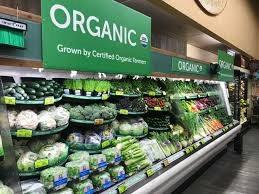 In a self-adulatory release, the Organic Trade Association listed responses to a consumer survey on familiarity with the organic seal. Of those responding, 88 percent were either familiar or somewhat familiar with the term “organic”. However, 86 percent were also aware of the “natural” designation, and 85 percent with “local” suggesting that the certified organic label is not necessarily unique or preeminent. It is also noteworthy that “pesticide free”, “vegan”, “raised without antibiotics” and “grass fed” all scored at or above 80 percent in terms of familiarity.
In a self-adulatory release, the Organic Trade Association listed responses to a consumer survey on familiarity with the organic seal. Of those responding, 88 percent were either familiar or somewhat familiar with the term “organic”. However, 86 percent were also aware of the “natural” designation, and 85 percent with “local” suggesting that the certified organic label is not necessarily unique or preeminent. It is also noteworthy that “pesticide free”, “vegan”, “raised without antibiotics” and “grass fed” all scored at or above 80 percent in terms of familiarity.
The Organic Trade Association understandably claims that recognition of the Organic seal and the implied connotation justifies the differential in price from corresponding non-organic food items. After decades of promotion and availability it is evident that twelve percent of consumers are still unfamiliar with the organic seal. This indicates the need for additional promotion of the claimed attributes of organic foods, requiring publicity and a justification of the price differential.

The survey also revealed that “fair trade” was relatively obscure with 58 percent of respondents either somewhat or very familiar with the term. “Humanely raised” scored 72 percent but was below the 76 percent for “hormone-free”. The lowest score of 33 percent for consumer familiarity was accorded “regenerative”.
It is apparent that the “certified organic” designation is clearly the leader among numerous label claims, but it is questioned whether consumers really understand the structure of the National Organic Program and what it offers. Foods accorded the certified organic seal are produced according to a set of regulations and standards that should eliminate the use of pesticides or additives that may be potentially deleterious. The requirement that foods be either non-GMO in origin or in the case of livestock products, derived from herds or flocks fed non-GMO feed, has no scientific justification with respect to human metabolism and health.

It is also noted that certification according to the National Organic Program is based on a review of documentation and is not supported by any structured program of laboratory assay to confirm freedom from GMO content, pesticides or additives. Annual FDA reports indicate low levels of detectable pesticide residues, not materially different from their organic equivalents. Pesticide assays conducted by the FDA yield levels below established non-effect values indicating the acceptability of conventional domestic fruit and produce. The USDA certified Organic Seal does not address food safety with respect to the potential presence of bacterial pathogens.
The Organic Trade Association clearly describes additional costs including production, processing, certification, and other fees to justify the higher cost of certified organic foods. The question arises as to whether consumers derive a commensurate benefit given the price differential between conventional and certified Organic products.